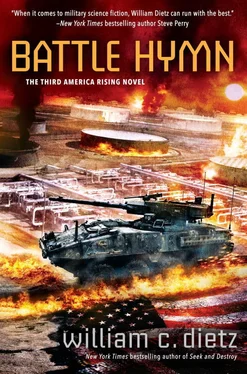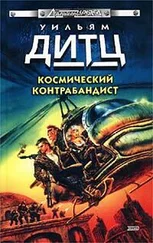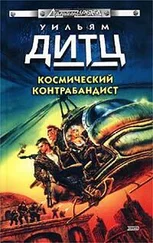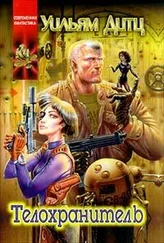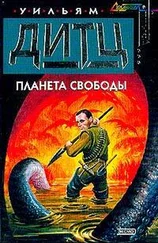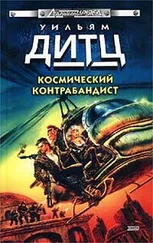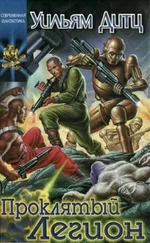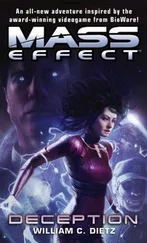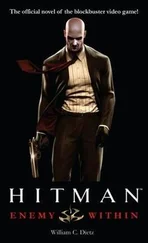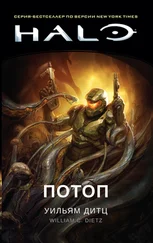William C. Dietz
BATTLE HYMN
This one is for Marvin Mack… gin connoisseur, science fiction aficionado, and friend.
You take the front line when there is danger. Then people will appreciate your leadership.
—NELSON MANDELA
EAST OF ALBUQUERQUE, NEW MEXICO
It was three in the morning. The past two days had been spent infiltrating troops into the hills east of Albuquerque, New Mexico. It would have been impossible without the snowstorm. But, thanks to the poor visibility, Union forces had been able to enter the area without being spotted. And one of those soldiers was the President of what had once been the United States of America.
However, even though Samuel T. Sloan was commander in chief of all armed forces, Captain Nick Black was in command of Charlie Company, 1st Battalion, 2nd Infantry Brigade from Fort Carson, Colorado. Because, as Sloan’s military attaché put it, “You aren’t qualified to lead a squad, much less a company.” And Sloan knew it was true.
So why was he there? Crouched under a tree? Waiting for the signal to attack rebel-held Albuquerque? Because it was important to walk the walk, that’s why. He was popularly known as the “Fighting President,” even though he could just as easily be called “the accidental president” since he had never run for political office.
The global disaster took place on May Day 2018, when sixty-plus meteors streaked through Earth’s atmosphere. Some struck the Pacific Ocean, sending tidal waves surging east and west. Others continued on, and one of them exploded over Washington State. The force of the blast was twenty to thirty times more powerful than the explosion that had leveled Hiroshima during WWII.
The secondary effects were even more devastating. Especially the widespread dispersal of particulate matter into the atmosphere. So much dust that the amount of sunlight reaching the surface of the planet was reduced by 15 percent. Plants died, the animals that fed on the plants died, and the humans who relied on both died. Millions upon millions of them.
America was hard-hit. Not only by the stuff in the atmosphere, and the effect that it had on crops, but by the meteors that struck Denver and Washington, D.C. In the blink of an eye, the top echelons of the federal government were annihilated, and Secretary of Energy Sloan became president.
Sloan had been in Mexico on May 1. And by the time he made it back and managed to assume the presidency, his badly shattered country had descended into chaos. There were pockets of civility. But large swaths of the country were controlled by warlords, religious groups, or no one at all. And that opened the way for a group of Libertarian oligarchs to form a new government in the American South. The Second Civil War followed.
Now, after many months of conflict, the Union Army was about to drive the Confederates out of Albuquerque. That was the plan, anyway. And some of the necessary groundwork had been laid. Thanks to arms supplied by the Union Army, a chief named Natonaba and a thousand Navajos had put the squeeze on the Confederate supply line that led up from Texas—and into New Mexico.
As a result, the rebs had to send heavy armor up Highway 285 north every time one of their convoys headed for Albuquerque. And, because the city was well within the reach of the Union Air Force, the Southerners couldn’t fly the supplies in either. All of which meant that the Confederates were running short of everything. That included food, fuel, and ammo.
The bastards did have one thing going for them, however—and that was the civilian hostages who were being held at key locations in the city. A situation that kept Union forces from bombing Confederate troop concentrations—and forced them to attack on the ground.
Sloan’s thoughts were interrupted as his platoon leader spoke on the radio. “This is Archer-Six. Move out. Watch those intervals and rotate the people on point every fifteen minutes. Over.” Sloan knew that the person on point would have to break trail for those who followed. That made it necessary to rotate people through the one slot in order to spread the work around. Not to mention the risk since the person on point was more likely to trigger an IED or catch a bullet.
Of course the lieutenant colonel in command of the battalion knew that. So, rather than send her people down the network of trails that could easily be booby-trapped, Barkley ordered each platoon to find its own way to the extent that was practical. And thanks to the mostly low, scrubby growth that covered the hills, her strategy was working.
To ensure that her troops didn’t get lost, Colonel Barkley had assigned local guides to each platoon. They were supposed to occupy the two slots right behind the point man and in front of the platoon leader.
As for Sloan, he was number eighteen in a twenty-six-person platoon, five of whom were Green Berets assigned to protect him. That in spite of Sloan’s opposition to any form of executive privilege. But Secretary of Defense Garrison and the rest of the cabinet were adamant. Sloan could accept the bodyguards or they would quit en masse. White House Chief of Staff Wendy Chow had been selected to deliver the message. “If you get yourself killed, or if the rebs manage to capture you, everything we’ve worked for will go down the toilet. So accept some bodyguards or run the administration by yourself.” Sloan had no choice but to agree.
Thanks to his night-vision gear, Sloan could see the soldier in front of him as she passed between snow-laden trees and circled a snowcapped boulder. Sloan’s snowshoes kept him from sinking into the powdery stuff. But they were clumsy, and his knees were starting to ache.
About three miles. That’s how far the platoon had to go in order to reach Kirtland Air Force Base, which was located adjacent to Albuquerque’s International “Sunport.” Kirtland had been home to the Materiel Command’s preimpact Nuclear Weapons Center a couple of months earlier.
But when it became clear that the rebs were going to capture Albuquerque, it had been necessary for air force personnel to destroy key parts of the facility as they withdrew. The ruins would make a good place to rally, however, and prepare for the final push into the airport, where more than a hundred civilian hostages were being held.
What were conditions like? Were the prisoners being fed? And what about the children? At least a dozen of them were being held in the main terminal, according to intelligence reports. Assuming all went well, this would be their last night in captivity.
Sloan had hoped to free Albuquerque earlier in the war but couldn’t do so without pulling much-needed soldiers out of the east, where General Hern couldn’t win without them. But thanks to recent successes, troops were available.
Sloan saw a flash of light and heard a loud bang. He raised the M4 but couldn’t spot any targets. “This is Archer-One,” Lieutenant Orson said. “We have a man down. No medic required. Keep moving.”
It seemed that the platoon’s point man had been killed by an IED, or a mine, in spite of the decision to stay off established paths. But where were the paths? Under many inches of snow, that’s where… And it looked as though the platoon had strayed onto one of them.
Had the enemy heard the explosion? Or seen the flash? Perhaps. But the curtain of steadily falling snow might have been sufficient to conceal the flash and muffle the sound.
Читать дальше
